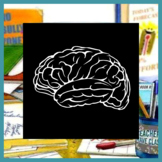This is Your Brain on Figurative Language: Brain-Science of Metaphors & Similes
- Word Document File
Also included in
- Use these to add more science into your writing class, or add more writing into your science class. I'm an author with two decades of experience teaching writing both in and out of a high school classroom. I'm also a big reader of science, especially behavioral science, and this has influenced bothPrice $6.75Original Price $7.50Save $0.75
Description
Do you know what a simile is? A metaphor? If you do, you can probably give me a hand with these definitions:
• A simile is a comparison that uses “like” or “as.”
• A metaphor is a comparison that does NOT use “like” or “as.”
Now that we’re all on the same page, I have to offer a confession: I taught figurative language using these two definitions for a huge chunk of my teaching career.
I never realized I was stuck in a rut. These textbook explanations blocked me from seeing that symbolic language was much deeper than the way I was teaching it. But then, very recently, I read something that turned everything I thought I knew on its head.
The excerpt that accompanies this introduction is from a book by Robert Sapolsky, who is such a respected scientists that even other scientists put him on a pedestal. It’s called, Behave: The Biology of Humans at Our Best and Worst. Sapolsky is not a poet. But when I read this, it hit me with the force of great poem.
Before we read it, though, I want to ask you not to take notes. Don’t try to capture everything on paper. Just sit back, block out other distractions, put your student hats on, and let Robert Sapolsky drop some poetic science on you.
The intro above has at least 15 examples of figurative language in it, but that won't become clear until after students have been introduced to Robert Sapolsky's beautiful explanation of how our brains process figurative language.
The full lesson plan includes:
- The intro above in handout form.
- An answer key that highlights all 17 examples of figurative language in the intro.
- The Robert Sapolsky quote and a summary of the book and chapter about how figurative language works in our brains.
- Writing prompts and ideas for expanding the lesson to fill a 45-minute class period or 90-minute block.
+++++
Roxanna Elden is the author of See Me After Class: Advice for Teachers by Teachers and creator of the new teacher Disillusionment Power Pack. If you’d like to sign up for monthly emails with free resources and funny, honest, practical tips for teachers, please visit roxannaelden.com.



